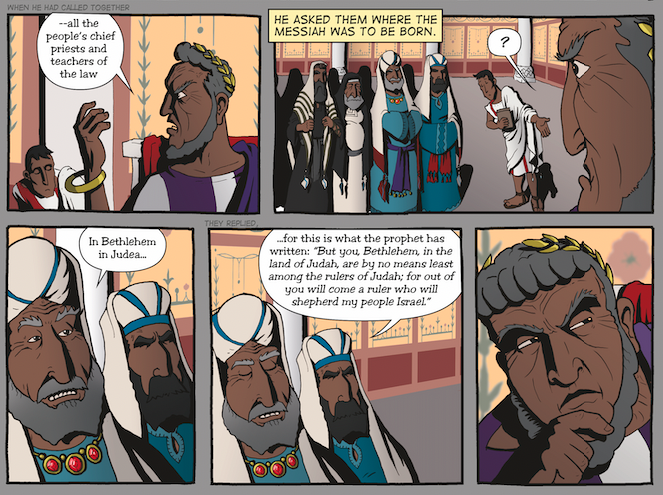King Herod is a key part of the Nativity Story.
Herod took the throne in 43 BC with the blessing of Rome after his predecessor died. “This appointment caused a lot of resentment among the Jews. After all, Herod was not a Jew. He was the son of a man from Idumea; and although Antipater (his father) had been a pious man who had worshipped the Jewish God sincerely, the Jews had always looked down upon the Idumeans as racially impure. Worse, Herod had an Arab mother, and it was commonly held that one could only be a Jew when one was born from a Jewish mother. When war broke out between the Romans and the Parthians (in Iran and Mesopotamia), the Jewish populace joined the latter.” [1]
Herod always considered himself “a friend of Rome.” After fleeing the Parthian invasion of 40 BC, he was restored to his throne by Octavian after Mark Anthony and the Roman forces drove the Parthians out of Judea.
Later, Herod navigated his way through political understanding to avoid being on the wrong side of a civil war between Mark Anthony and Octavian. He was dubbed “the Great” for his many building works and long reign.
“He continued his building policy to win the hearts of his subjects. ... In Jerusalem, King Herod built a new market, an amphitheater, a theater, a new building where the Sanhedrin could convene, a new royal palace, and last but not least, in 20 BCE, he started to rebuild the Temple.” [1] He built several palaces and fortresses, including Masada, on top of a 1,300-foot-high mesa-like plateau. One of King Herod's most significant achievements was a massive port that he built in honor of the emperor and called Caesarea.
“However, many of his projects won him the bitter hatred of the orthodox Jews, who disliked Herod's Greek taste—a taste he showed in his building projects and several transgressions of the Mosaic Law.
“The orthodox were not the only ones who came to hate the new king. The Sadducees hated him because he had terminated the rule of the old royal house to which many were related; their influence in the Sanhedrin was curtailed. The Pharisees despised any ruler who despised the Law. And probably all his subjects resented his excessive taxation. ... It is no surprise that Herod sometimes had to revert to violence, employing mercenaries and secret police to enforce order.” [2]
King Herod's tenure ended in a reign of terror. In the last few years of his life, the king became ill with what is believed to be a cancer-like affection called Fournier's gangrene. Whether it was the necrosis of his body or his impending death that caused it, Herod seems to have become paranoid and dangerously insane at this time.
Herod burnt rebellious Jewish teachers and their pupils alive for removing a golden eagle from the entrance of the Temple. He arranged for a large number of people to be executed or assassinated, including two of his wives, three of his sons, and his mother-in-law, when he suspected them of conspiracy. According to the Macrobius, Emperor Augustus quipped, “It is better to be Herod’s pig than a son” (Saturnalia 2:4:11 c.431 AD)
“As a final act of vengeance against his contemptuous subjects, he rounded up leading Jews and commanded that at his death, they should be executed. He reasoned that if there was no mourning for his death, at least there would be mourning at his death! (At Herod’s death, the order was overruled, and the prisoners were released.)” [3]
Considering this unbridled psychosis and Herod's lineage, we can understand much more about his encounter with the Parthian Magi in the Nativity Story. "It would seem as if these Magi were attempting to perpetrate a border incident which could bring swift reprisal from Parthian armies. Their request of Herod regarding the one who ‘has been born King of the Jews’ (Matt 2:2) was a calculated insult to him, a non-Jew who had contrived and bribed his way into that office.” [2]. This helps contextualize the innocents' slaughter (Matt 2:2) and explains why the Magi took a different way when they returned to the East after they visited with Jesus.
[1] https://www.livius.org/articles/person/herod-the-great/
[2] Who were the Magi https://www.khouse.org/articles/1999/142/
[3] https://www.biblegateway.com/blog/2017/12/who-was-herod/
This article is an extract from our new Christmas nativity graphic novel. Find it in our online store : https://www.wordforwordbiblecomic.com/buy



































